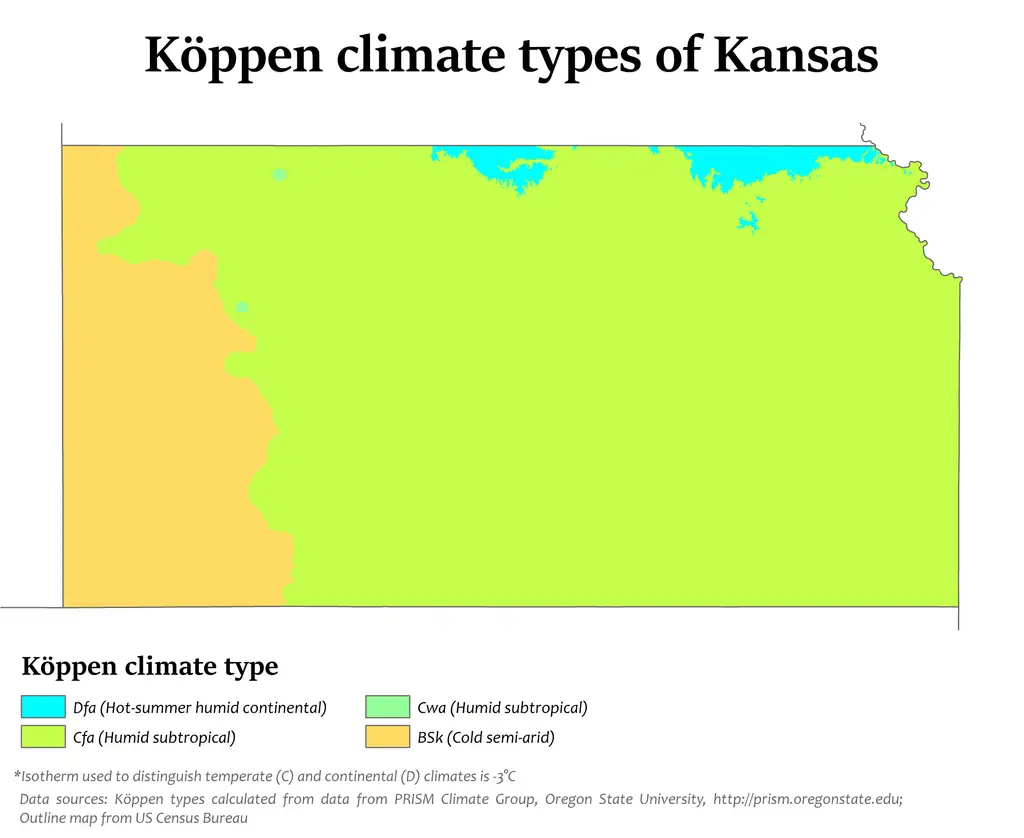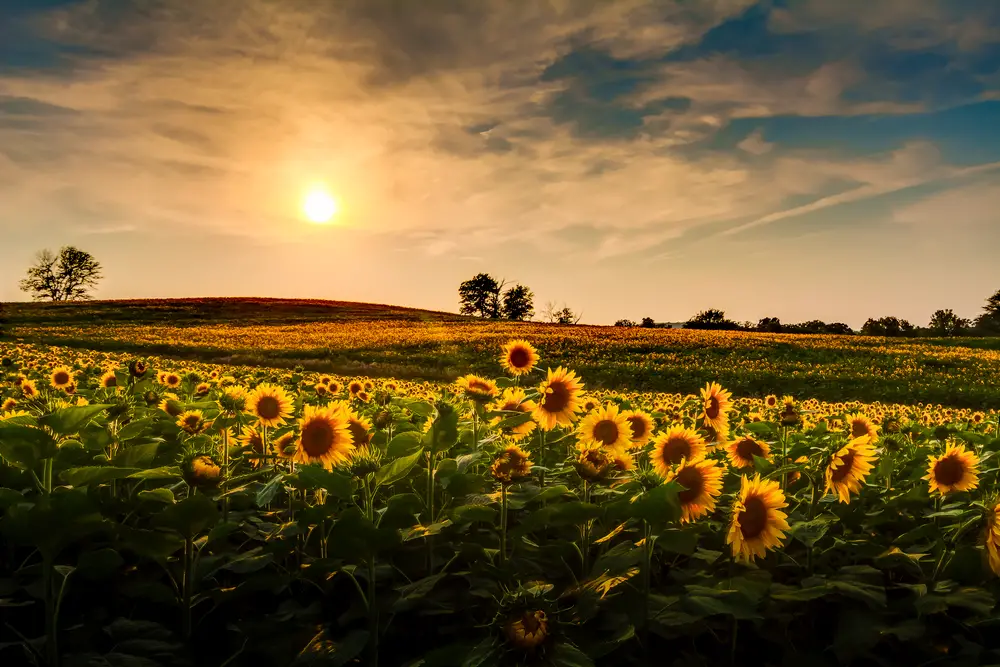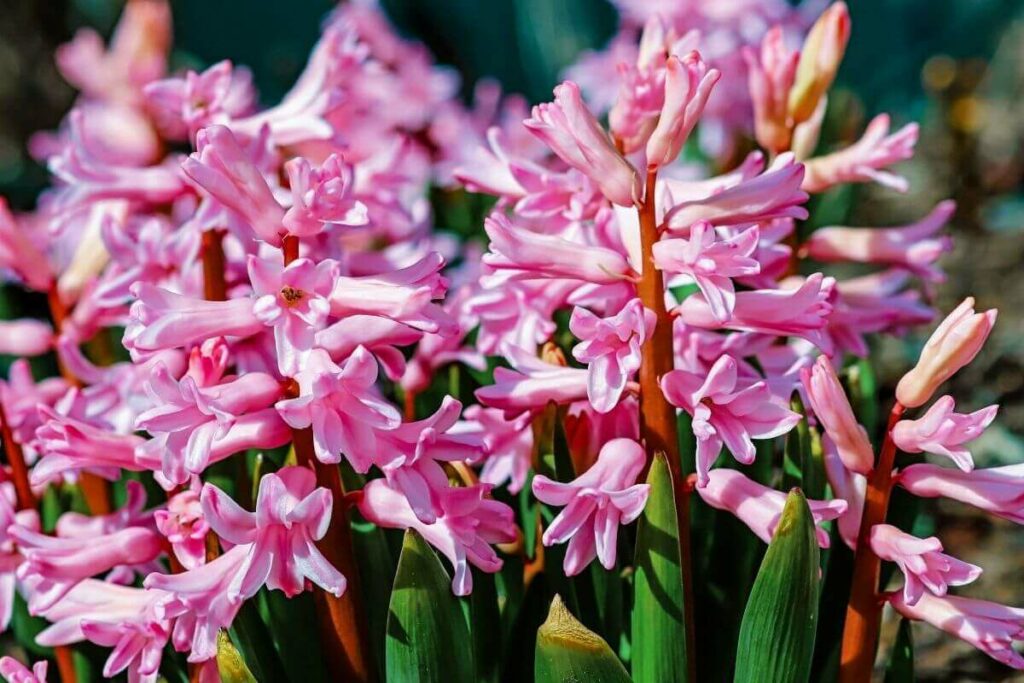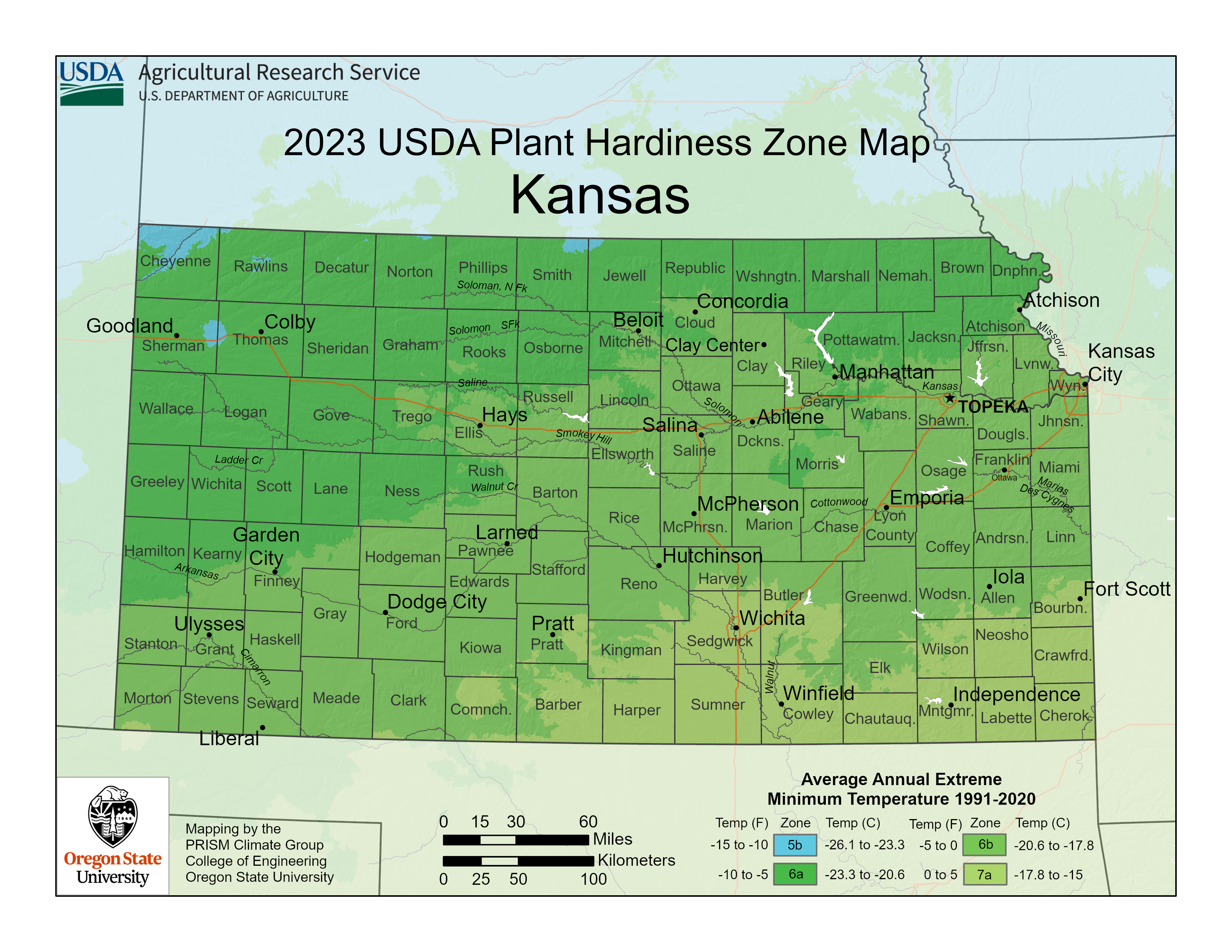Kansas Plant Hardiness Zones
| USDA Hardiness Zone | Average Minimum Extreme Winter Temperature Range Fahrenheit (°F)Celsius (°C) | Average Last Frost Date Range In Spring (Beginning Of The Growing Season) | Average First Frost Date Range In Autumn (End Of The Growing Season) |
|---|---|---|---|
| 5b | -15°F to -10°F -26.1°C to -23.3°C | Early to mid-May | Mid-October |
| 6a | -10°F to – 5°F -23.3°C to -20.6°C | Late April | Late October |
| 6b | -5°F to 0°F -20.6°C to -17.8°C | Late April | Late October |
| 7a | 0°F to 5°F -17.8°C to -15°C | Late March to early April | Early to mid-November |
Kansas Growing Conditions
General Climate

The eastern two-thirds of Kansas is primarily a humid continental climate. It can be split into two distinct geographic areas: the Central Plains and the Glaciated Region.
The Central Plains has cool (ranging to cold) winters and hot, humid summers. It receives most of its precipitation in the spring and summer.
The Glaciated Region encompasses Northeast Kansas and has some of the richest agricultural soil in the state. This area gets good rain and has a long growing season (200 days).
The western third, the High Plains, is drier and a semi-arid steppe. It is an area of rolling hills and flatlands and receives less precipitation than most of the state. The combination of limited precipitation, wind, and sun means the region is dry.
The southeastern portion of the state, including the Ozark Plateau, is notably wet and warm and classified as humid subtropical. This area is one of the few in the state that receives enough precipitation to support plant growth without irrigation.
Microclimates
USDA plant hardiness zones are an important starting point for your garden, but you’ll also need to consider microclimates.
Microclimates are areas where specific conditions create a climate different from the climate they’re situated in.
Buildings, fences, paved areas, or short hills and valleys can create these microclimates.
They can be as small as a space in your backyard or as large as a city.
In other words, learn about your local conditions from local experts to see if your garden falls into a microclimate.
Extreme Weather
Due to its location and the combination of several types of air masses in the area, Kansas is known for its sometimes extreme weather. Strong storms, which typically develop most in the spring and summer, can be exceptionally damaging to growing plants. They include thunderstorms, strong winds, hail, and even tornadoes.
Strong Storm Winds
Strong storm winds can cause breakage to even established and woody plants in your garden. Even if breakage doesn’t occur, plants can be susceptible to leaning, impacting their growth and long-term health.
The best way to prevent and correct wind damage in your garden is to give your plants physical support (see the “Gardening Tips” section).
Flooding
Flooding can cause significant damage to a garden. First, it cuts off oxygen to roots, and then it can create rot and disease. If flooding is a problem in and around your garden, you will need to take steps to mitigate it.
Potential solutions include:
- Gardening in raised beds, so that excess water can easily drain away
- Container planting, so that you can move containers at will and protect plants from elements
- Installing a rain garden, so that excess water will be more likely to drain according to your design
- Ensuring positive drainage away from your house and garden to prevent standing water where your plants are growing
Hail
Storms in Kansas can produce baseball- to softball-sized hail. Even storms that produce significantly smaller hail stones cause catastrophic damage to gardens and even structures such as greenhouses or polytunnels that some may use to circumvent hail damage.
Cover your garden to prevent destruction and be quick to remove any damage or decay from remaining plants after storms have passed through.
If plants have been damaged too much to survive, you may need to start anew and replant with new plants. You will know within a day or two after the storm which plants will recover.
Growing Season
For most of Kansas, the growing season runs from approximately April to October (March to November in the warmest locales). Though learning about your region’s frost dates is an important resource for gardening success, weather conditions are dynamic. Tuning in to local weather reports will improve your knowledge even further.
Learn just how prone your area is to storms, connect with other local growers, and share tips on how to deal with said storms. Doing so will provide you with a much more enjoyable (and successful) growing season.
Kansas Gardening Tips

Choose Native Species
We always recommend choosing native species when selecting plants for your garden. These plants are the most likely to thrive in your region because they are adapted to it. Additionally, native plants do not take over and choke out other species, as some introduced species do.
In Kansas, outside of the few geographic pockets of wetter conditions, getting enough water to plants to ensure their growth can be challenging. So, selecting varieties used to limited water resources and able to survive anyway can benefit your garden.
Use Mulch
Placing a layer of organic materials around the base of your growing plants, such as grass clippings, decomposing leaves, wood chips, straw, or even finished compost can also help you manage sparse water resources. This practice is known as mulching.
Mulching keeps plant roots cooler than if exposed and retains moisture in the soil that would otherwise evaporate due to prolonged sunlight and wind.
Mulching also helps build both the structure and nutrients within the soil it covers as it decomposes over time. The more you can improve the soil structure you are growing in, the better its water-carrying capacity will be. This means your soil will be able to easily accept and hold onto water it receives.
Follow Best Watering Practices
Freshwater is always precious, but it can become even more so in situations where it becomes scarce. As such, it is best to maximize whatever water is available.
Watering at the soil line is best for your plants. You may want to use drip irrigation.
The best times of day to water are early or late (we do not recommend watering late in the day in wetter climates as it can too easily promote disease). This ensures your plants have enough water before the heat of the day and reduces the amount of water lost to evaporation.
It is also better to water your plants less frequently (once or twice a week) and to water deeply. This allows moisture to penetrate deeper into the soil and encourages your plants to grow deeper roots (to access the water held in the soil).
Practice Winter Care
In locations where freezing will occur over the winter months, prepare your garden for the winter. Basically, you want to ensure plants will survive cold temperatures.
As temperatures cool, plant growth slows down. Depending on temperatures, plants will enter a state of dormancy over the winter.
Their needs become much more basic than during the warm season, characterized by periods of vigorous growth. Winter plant care includes deep watering in the fall and insulating plants from extreme temperature fluctuations that could cause them harm.
Deep Watering In Autumn
The cold winds of winter cause plants to lose moisture and dry out. Cold or frozen soil can prevent moisture from absorbing into the soil.
Your plants will survive better if they start the winter well-hydrated. A deep and thorough watering in the autumn just before the first frost ensures your plants are well watered and the soil is appropriately moist to survive winter.
Insulate Your Plants
In Kansas, it isn’t the extreme cold that puts plants at risk of dying over the winter, it is the wide variability of temperatures that causes stress.
Using burlap wraps to protect trees and shrubs (especially newly planted ones) can offer some insulation from harsh elements.
Adding a layer of mulch to cover the soil and insulate roots is also helpful. It will retain moisture and protect your plant roots from being exposed to potentially harmful temperature variations.
Give Your Plants Supports
As a state that experiences a great deal of wind and other potentially extreme weather, Kansas’s plants need physical support.
Installing tomato cages, trellises, and staking while planting protects plants from strong winds. In addition, these supports can double as frames to attach sheets, floating row cover, poly sheeting, or any manner of frost cloth when seeking coverage from storms or at the beginning or end of your growing season.
Considerations For Gardening In Wet Areas of Kansas
Given high levels of precipitation in the northeast and southeast corners of Kansas, you’ll need to pay special attention to managing the effects of too much moisture in your garden (namely pests and diseases) if you live there.
You can do this through:
- Choosing varieties that have been bred for disease resistance.
- Transplanting only the healthiest plants.
- Using barriers such as tin cans or floating row cover to protect newly transplanted plants from pests.
- Planning gardens with enough spacing to ensure good airflow even as they get larger throughout the growing season.
Consult With Local Professionals
Consulting with local gardening professionals allows you to benefit from their experience with your area’s conditions, the plants that do well there, and overall best practices.
Kansas Plant Suggestions

Trees
- Pawpaw (Asimina triloba)
- Cottonwood (Populus deltoides)
- Hackberry (Celtis occidentalis)
Shrubs
- Flowering Dogwood (Cornus florida)
- Fragrant Sumac (Rhus aromatica)
- Wild Crabapple (Malus coronaria)
Flowers
- Poppy Mallow (Callirhoe involucrate)
- Wild Hyacinth (Camassia scilloides)
- Rigid Goldenrod (Solidago rigida)
Vegetables
- Beans (Phaseolus vulgaris)
- Corn (Zea mays)
- Onions (Allium cepa)
Herbs
- Yellow Giant Hyssop (Agastache nepetoides)
- Thyme (Thymus vulgaris)
- Culinary Sage (Salvia officianalis)
Spices
- Mustard (Brassica juncea)
- Sesame (Sesamum indicum)
- Paprika (Capsicum annuum)
Fruits
- Sandhill Plum (Prunus angusifolia)
- Nectarines (Prunus persica)
- Cherries (Prunus avium)
Succulents
- Hens And Chicks (Sempervivum tectorum)
- Whale’s Tongue Agave (Agave ovatifolia)
- “Turquoise Tails” Sedum (Sedum sediforme)
Disclaimer
Any of the above can change and is not exhaustive.
Treat anything above like a good starter guide. Then use that as a foundation as you consult with local gardeners, professionals, forecasts, guides, and organizations.

